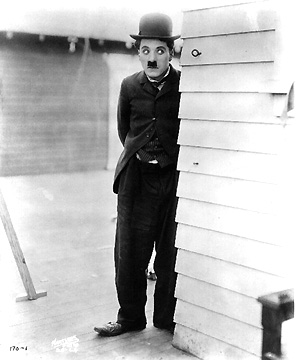Chaplin's Career
 Joins Fred Karno troop at age 17.
Joins Fred Karno troop at age 17.
Goes to work for Mack Sennett in 1912 for $175/week.
Moves to Essanay in 1915 for $1,250/week.
Moves to Mutual in 1916 for $10,000/week plus bonuses.
Moves to First National in 1918 for $1,000,000 (almost $20 million in 2022).
When Chaplin's contract runs out, he forms United Artists (with Griffith, Pickford, and Fairbanks) and never works
for a studio again.
This is critical because it allows him to maintain total control over his films.
One reason for Chaplin's success is that he had an excellent business partner; his older half brother Sidney Chaplin (1885-1965).
Next: films
 Fred Karno, born Frederick John Wescott (1866-1941) was to the UK as Mack Sennett was to the US, but a generation earlier. He was a master of slapstick and a great discoverer and mentor to talent. He was an impresario of British Music Hall entertainment. Music Hall was like Vaudeville, except it (mostly) lacked Vaudeville's racist elements (and had no roots in US minstrelsy). He's credited, among other things with popularizing the custard-pie-in-the-face gag. In addition to mentoring Chaplin and his brother Sydney, in he's also remembered for his mentorship of Stan Laurel (1890-1965) and many, many comedians who were famous in the UK throughout the 20th century (if you aren't familiar with Stan Laurel, follow this link Laurel is the skinny one, Oliver Hardy (1982-1957) the heavier one). Karno briefly worked for Hal Roach studios (writing for Laurel and Hardy comedies) but his experience in the US was not good and he soon returned to England. At the time that Karno and Chaplin toured the US (1910-1912), Karno and Music Hall entertainment in general, were at the height of their popularity. However, the fate of Music Hall was much the same as that of Vaudeville, and Karno went bankrupt in 1927 (and moved with mediocre success to movies and regular theater).
Fred Karno, born Frederick John Wescott (1866-1941) was to the UK as Mack Sennett was to the US, but a generation earlier. He was a master of slapstick and a great discoverer and mentor to talent. He was an impresario of British Music Hall entertainment. Music Hall was like Vaudeville, except it (mostly) lacked Vaudeville's racist elements (and had no roots in US minstrelsy). He's credited, among other things with popularizing the custard-pie-in-the-face gag. In addition to mentoring Chaplin and his brother Sydney, in he's also remembered for his mentorship of Stan Laurel (1890-1965) and many, many comedians who were famous in the UK throughout the 20th century (if you aren't familiar with Stan Laurel, follow this link Laurel is the skinny one, Oliver Hardy (1982-1957) the heavier one). Karno briefly worked for Hal Roach studios (writing for Laurel and Hardy comedies) but his experience in the US was not good and he soon returned to England. At the time that Karno and Chaplin toured the US (1910-1912), Karno and Music Hall entertainment in general, were at the height of their popularity. However, the fate of Music Hall was much the same as that of Vaudeville, and Karno went bankrupt in 1927 (and moved with mediocre success to movies and regular theater).
 Joins Fred Karno troop at age 17.
Joins Fred Karno troop at age 17. Fred Karno, born Frederick John Wescott (1866-1941) was to the UK as Mack Sennett was to the US, but a generation earlier. He was a master of slapstick and a great discoverer and mentor to talent. He was an impresario of British Music Hall entertainment. Music Hall was like Vaudeville, except it (mostly) lacked Vaudeville's racist elements (and had no roots in US minstrelsy). He's credited, among other things with popularizing the custard-pie-in-the-face gag. In addition to mentoring Chaplin and his brother Sydney, in he's also remembered for his mentorship of Stan Laurel (1890-1965) and many, many comedians who were famous in the UK throughout the 20th century (
Fred Karno, born Frederick John Wescott (1866-1941) was to the UK as Mack Sennett was to the US, but a generation earlier. He was a master of slapstick and a great discoverer and mentor to talent. He was an impresario of British Music Hall entertainment. Music Hall was like Vaudeville, except it (mostly) lacked Vaudeville's racist elements (and had no roots in US minstrelsy). He's credited, among other things with popularizing the custard-pie-in-the-face gag. In addition to mentoring Chaplin and his brother Sydney, in he's also remembered for his mentorship of Stan Laurel (1890-1965) and many, many comedians who were famous in the UK throughout the 20th century (